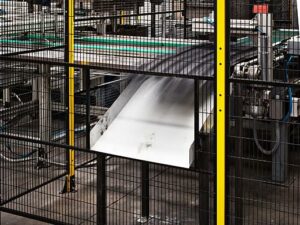Steve Allen, Sales Manager for Procter Machine Guarding, explains the simple steps to be taken when specifying a modular perimeter guarding system for use around machinery.
Perimeter Guards’ Advantage for your Machine Safety
One of the advantages of using a modular perimeter guarding system is that it requires significantly less engineering time and effort than designing perimeter guards from scratch. For systems such as the Satech range, which is available in the UK from Procter Machine Guarding, the requisite guards can be specified by following a simple step-by-step procedure. Moreover, to complement its supply and installation services, Procter Machine Guarding also offers to undertake a site survey and specify all of the components required, which makes life even easier for customers.
Step 1: Define application of product range

How to specify a modular perimeter guarding system
But for customers wishing to specify the Satech system themselves, the first step is to decide which product range best suits the application. Unlike other modular perimeter guarding systems that are sold on the basis of ‘one size fits all,’ the Satech system recognises that different applications require guards with different strengths and that customers should only have to pay for what they need. The Satech ‘Basic’ system is appropriate for at least 80 percent of projects, or the ‘Strong’ system is suitable for more demanding applications. Should neither of these modular ranges be suitable, Procter Machine Guarding can supply cost-effective bespoke guards.
Step 2: Plan drawings indicate Dimensions & Access
Having chosen the type of guarding required, the customer’s next step is to prepare basic plan view drawings or dimensioned sketches that indicate the overall dimensions and the approximate positions of access points. Working from these, Procter supplies 2D/3D CAD drawings/models by return. These show what dimensions can be achieved using only standard modular components; in general, the customer’s requirements can be met within +/-60mm using standard components (however, Procter can supply custom components if an acceptable design cannot be achieved using standard parts alone).
In addition to the plan view layout geometry, the customer needs to indicate the types of access required – for example, hinged or sliding gates. For both the access points and the guarding, the customer needs to choose the infill material required, which may also vary around the perimeter. Usually welded wire mesh (weldmesh) is selected, though panels can also be provided in polycarbonate, sheet metal or a combination of materials.
Standards Compliance
While the norm for high-risk areas is to use perimeter guarding with a height of 2000mm, customers need to be aware of the need to comply with BS EN ISO 13857:2008, ‘Safety of machinery – Safety distances to prevent hazard zones being reached by upper and lower limbs,’ which has recently superseded BS EN 294 for upper limb access and BS EN 811 for lower limb access. If customers wish to check the heights for themselves Procter offers a free Safety Distance Calculator, or the company’s engineers can establish the correct guard height as part of the site survey and specification service.
Finish
The standard polyester powder coated finish with yellow posts and black panels give good visibility of the machinery as well as an attractive appearance. Other colours can be supplied to order, but these may be subject to an additional charge.
Customers generally specify the interlocks to be used at access points, and Satech access doors are designed to accommodate any electrical or mechanical interlock devices. However, to eliminate the risk of any problems arising during installation, the customer must state what is to be used so that Procter’s engineers can check the compatibility prior to delivery.
Considering Bespoke Guarding
The Satech system is one of the most comprehensive modular perimeter guarding systems on the market, but there are occasions where using only standard modular components is unfeasible. Fortunately, Procter Machine Guarding is also a manufacturer of bespoke guarding, so can readily modify Satech components or design and supply custom components to match the Satech range – such as counterbalanced doors, entry/exit tunnel guards, or panels with complex cutouts to fit around machinery or building structures. To specify these modified or custom components, customers simply have to add a note to the drawings/sketches and Procter Machine Guarding will take care of the design and manufacture.
Professional Comprehensive Machine Guarding Services from Procter
From the above, it can be seen how simple it is to specify modular perimeter guarding, especially when working with the Satech system. However, for the ultimate in simplicity and the minimum requirement for time and effort from the customer, it is best to hand the complete project to Procter Machine Guarding in the knowledge that an optimised, cost-effective system will be specified, designed and installed in line with all relevant machinery safety standards, and a Certificate of Conformity supplied on completion. The Procter Machine Guarding service is also accredited to BS EN ISO 9001:2008, reflecting the company’s commitment to delivering products and services that meet the highest quality standards.
To discuss any requirements for modular perimeter guarding, please email Procter Machine Safety or telephone.
